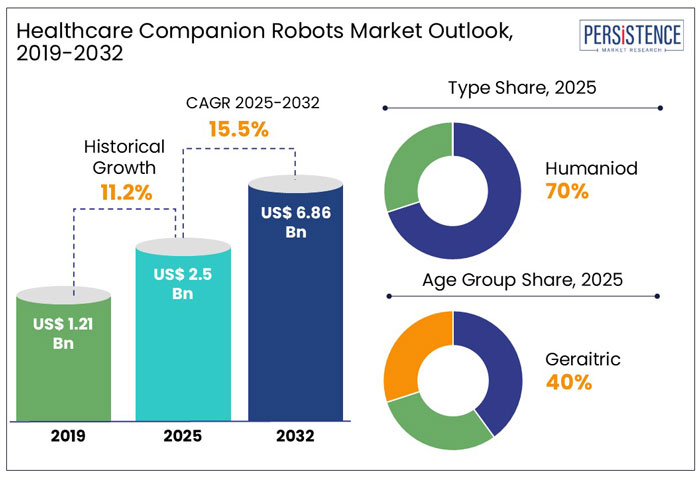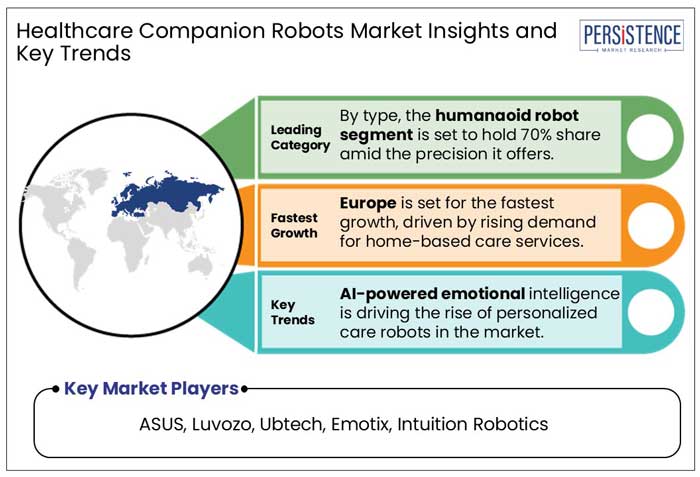Industry: Healthcare
Published Date: March-2025
Format: PPT*, PDF, EXCEL
Delivery Timelines: Contact Sales
Number of Pages: 250
Report ID: PMRREP35172
The global healthcare companion robots market size is anticipated to rise from US$ 2.50 Bn in 2025 to US$ 6.86 Bn by 2032. It is projected to witness a CAGR of 15.5% from 2025 to 2032.
Healthcare facilities were never as innovative as today's AI-powered healthcare solutions. AI-powered healthcare companion robots aid patient care by assisting patients with their medications and daily routines and even suggesting exercises.
Unlike industrial robots, healthcare companion robots are designed to understand human emotions and provide psychological support.
Hospitals and rehabilitation centers are increasingly deploying social robots like Moxi, which assist overburdened nurses by delivering medical supplies, allowing healthcare professionals to focus on patient care.
"Buddy," a social robot, is helping autistic children improve communication skills through AI-driven interactive learning. Paro, the robotic seal used in dementia care, has been shown to reduce stress and anxiety in 70% of elderly patients.

Key Highlights of the Healthcare Companion Robots Market
|
Global Market Attributes |
Key Insights |
|
Healthcare Companion Robots Market Size (2025E) |
US$ 2.50 Bn |
|
Market Value Forecast (2032F) |
US$ 6.86 Bn |
|
Projected Growth (CAGR 2025 to 2032) |
15.5% |
|
Historical Market Growth (CAGR 2019 to 2024) |
11.2% |
Shortage of Healthcare Workers Spurred the Need for AI-Powered Companion Robots
During the historical period from 2019 to 2024, healthcare companion robots were seen as futuristic but niche solutions primarily used in elder care, rehabilitation, and pediatric therapy.
The market experienced steady growth, driven by an aging population, increasing loneliness among seniors, and a shortage of healthcare workers.
However, adoption remained concentrated in developed regions like North America, Japan, and parts of Europe, where government initiatives backed AI-driven healthcare solutions.
Countries with Aging Population to Surge Companion Robots Demand
Over the forecast period, the market landscape is expected to transform dramatically, with AI and robotics becoming more sophisticated and affordable. Healthcare companion robots will evolve beyond basic caregiving to advanced emotional intelligence and real-time health monitoring.
Countries with aging populations, like China and South Korea, will rapidly adopt companion robots as a necessity rather than a luxury, underlining the urgency of adoption. By 2030, over 60% of elderly care facilities globally are expected to use AI-powered robotic caregivers.
As healthcare shifts towards personalized, tech-driven solutions, healthcare companion robots will become an indispensable part of patient care. The companion robots will play a crucial role in bridging the gap between human empathy and technological efficiency, reassuring stakeholders about the future of patient care.
Shortage of Healthcare Workers and Burnout Crisis to Augment Market Prospects for Companion Robots
Healthcare systems worldwide face a severe shortage of workers, with reports indicating that by 2030, there could be a shortfall of 15 million healthcare professionals globally. Nurses, doctors, and caregivers are overburdened, leading to burnout and reduced patient care quality.
Healthcare companion robots such as Moxi and Buddy are stepping in to handle non-critical tasks like delivering medical supplies, checking vitals, and offering companionship to patients.
By automating routine tasks, these robots allow nurses and doctors to focus on critical patient care, ultimately improving efficiency and reducing stress levels.
Hospitals and long-term care facilities are increasingly investing in AI-driven robotics to optimize workflows, with some estimates predicting that by 2027, 60% of healthcare institutions will integrate robotic assistants. The shift is not about replacing human caregivers but enhancing their efficiency and reducing workload stress, making the industry more sustainable in the long run.
Ethical Concerns and Limited Human Interaction to Restrict Market Growth
Despite their ability to provide companionship and support, healthcare companion robots lack human empathy and emotional depth, raising ethical concerns about their caregiving role. Critics argue that replacing human caregivers with robots could lead to emotional detachment, especially among elderly individuals who require deep emotional connections.
The privacy and data security risks associated with AI-driven robots remain a major concern. Companion robots collect sensitive health data, personal preferences, and daily routines, making them potential targets for cyberattacks and data breaches.
Ensuring strong data protection laws, AI ethics regulations, and transparent user control mechanisms will be critical for building trust in this technology. To address these concerns, healthcare providers are integrating hybrid models, where robots assist but do not replace human caregivers.
AI-Powered Emotional Intelligence for Personalized Care to Boost Market Demand
AI-powered emotional intelligence is one of the most transformative opportunities in the market. Future companion robots will be able to recognize human emotions, respond with appropriate gestures, and even offer personalized mental health support.
For example, socially assistive robots (SARs) like Paro, the robotic seal, and ElliQ have already shown how AI can help reduce loneliness among the elderly. These robots analyze facial expressions, tone of voice, and speech patterns to detect mood changes and respond with comforting interactions.
With advancements in AI and natural language processing (NLP), robots will evolve into empathetic caregivers, helping patients with dementia, depression, and PTSD. It could revolutionize elderly care, mental health therapy, and rehabilitation programs, offering round-the-clock emotional support where human caregivers might not always be available.
Humanoid Robots Led the Type Category with 70% Market Share Due to its Precision
The humanoid type of companion robots led the market share, capturing the most significant market share because of advantages such as precision and fewer human errors.
Such robots are progressively employed to facilitate techno-psychological distractions for youngsters during medical interventions. This method alleviates discomfort linked to anxiety and stress.
The increasing need for robots is linked to the expanding population of individuals with impairments. The humanoid robots mitigate the obstacles people encounter through effective environmental interaction, fostering humanoid robots' commercial expansion.
Geriatric Age Group Dominates with 40% of the Market Share
The geriatric age group led the global market share, representing the biggest revenue share of 40%. Globally, the number of elderly individuals is rising, leading to a greater need for assistance in daily activities, health monitoring, and companionship. Healthcare companion robots effectively address these needs.
Elderly individuals often face chronic health issues such as Alzheimer's and dementia. Robots equipped with artificial intelligence can assist in managing these conditions by providing reminders, cognitive exercises, and monitoring health metrics.
Companion robots enable aged people to maintain independence by assisting with daily tasks and providing a sense of companionship, thereby improving their quality of life. The convergence of an aging global population, the prevalence of chronic conditions among the elderly, and advancements in robotic technologies have positioned the geriatric as the leading age group in the market.

Asia Pacific led the global market, capturing the biggest revenue share of 51%. The region's dominance is primarily attributed to its swiftly aging population, especially in Japan, China, and South Korea.
Governmental measures designed to enhance healthcare technology adoption, coupled with increasing expenditures in artificial intelligence and robotics, are propelling market expansion.
Enhanced research and development initiatives are further propelling the healthcare companion robotics sector. The proliferation of new product releases and ease of approvals in the region stimulate market expansion.
North America is anticipated to experience substantial expansion over the forecast period, driven by the region's advanced healthcare infrastructure, elevated levels of technology innovation, and aging demographic.
The increasing scarcity of healthcare specialists and the escalating incidence of age-related health concerns are propelling market expansion.
A strong emphasis on research and development has led to the creation of sophisticated humanoid robots capable of assisting in various healthcare settings. With a growing number of elderly individuals, there's an increasing demand for companion robots to support independent living and manage chronic conditions.
The US is expected to have significant expansion throughout the forecast period. The escalating healthcare expenses and a deficiency of caretakers are propelling the expansion of the healthcare companion robots sector.
The healthcare companion robots market in Europe is anticipated to have the most rapid expansion during the forecast period. The growth is driven by an aging population, increasing need for home-based care, and a significant focus on technological innovation in healthcare.
Elevated consumer adoption of robotics is anticipated to advance the market in the European region. For instance, the German market is expected to exhibit the highest growth rate throughout the forecast period.
The rising demand for automation in aged care, rehabilitation, and healthcare delivery is driving market expansion in Europe. Further, the rising trend of home care services and the increased emphasis on patient-centered care are contributing to market expansion.
The healthcare companion robots market is witnessing robust growth, driven by technological advancements and a rising demand for innovative caregiving solutions.
The industry's key players offer diverse products ranging from humanoid robots to animal-like companions. Intuition Robotics, for instance, introduced ElliQ, a digital care companion designed to promote physical activity and social engagement among older adults.
Major companies focus on integrating artificial intelligence to enhance emotional intelligence in robots, addressing issues like loneliness among the elderly. The competitive landscape is characterized by continuous innovation, strategic partnerships, and a commitment to improving users' quality of life, positioning these companies at the forefront of the market.
Key Industry Developments
|
Report Attributes |
Details |
|
Historical Data/Actuals |
2019 - 2024 |
|
Forecast Period |
2025 - 2032 |
|
Market Analysis Units |
Value: US$ Bn/Mn, Volume: As applicable |
|
Geographical Coverage |
|
|
Segmental Coverage |
|
|
Competitive Analysis |
|
|
Report Highlights |
|
|
Customization and Pricing |
Available upon request |
By Type
By Age Group
By End Use
By Region
To know more about delivery timeline for this report Contact Sales

The market is set to reach US$ 2.50 Bn in 2025.
ASUS, Luvozo, Ubtech, are a few leading players in the industry.
The industry is estimated to rise at a CAGR of 15.5% through 2032.
The market is anticipated to reach a valuation of US$ 6.86 billion by 2032.
The healthcare robot market is anticipated to reach a valuation of US$ 16.5 billion in 2025.